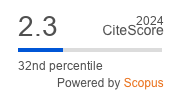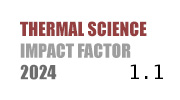ABSTRACT
This study aims to develop a zero-energy building (ZEB) by optimizing required energy consumption in an industrial building complex. The complex uses an electric compression chiller to meet heating and cooling demands. To achieve this goal, four multi-energy generation systems are proposed, leveraging renewable resources. Building Energy Optimization (Beopt) software is used for simulation, and the EES software is employed to design the energy-supplying systems. The results indicate that the industrial building complex consumes 50,656.29 kWh of electricity, 436,221.62 kWh of heating, and 8,073.36 kWh of cooling annually. The four systems are optimized using the Response Surface Methodology (RSM), focusing on exergy efficiency (EE) and cost rate (CR). System D emerges as the most efficient, with an average EE of 22.35% and an average CR of 8.9 $/h. This system generates 726,090.61 kWh of electricity, approximately 1.06 million kWh for heating purposes, and around 760,000 kWh for cooling needs, making it a suitable system for the complex. Ultimately, this study presents an efficient system with the best cost rate and performance for the energy supply of the studied industrial building, contributing to a more sustainable and environmentally friendly energy strategy.
KEYWORDS
PAPER SUBMITTED: 2025-04-29
PAPER REVISED: 2025-07-25
PAPER ACCEPTED: 2025-08-02
PUBLISHED ONLINE: 2025-09-13
- Zhang, S., et al. (2022). "Renewable energy systems for building heating, cooling and electricity production with thermal energy storage." Renewable and Sustainable Energy Reviews 165: 112560
- Walmsley, T. G., et al. (2023). "Hybrid renewable energy utility systems for industrial sites: A review." Renewable and Sustainable Energy Reviews 188: 113802
- Nkini, S., et al. (2023). "Comparative analysis of the energy performance in green and non-green office buildings in Dar Es Salaam, Tanzania." Energy and Buildings 293: 113202
- Noohian, M. and J. Mahmoudi (2023). "Energy simulation on how to go green buildings in an earth's dry climate." International Journal of Thermofluids 20: 100405
- Cheraghi, R. and M. Hossein Jahangir (2023). "Multi-objective optimization of a hybrid renewable energy system supplying a residential building using NSGA-II and MOPSO algorithms." Energy Conversion and Management 294: 117515
- Jafarian, M., et al. (2023). "Optimal tariffs of resources and users scale size for a combined Cooling, Heat, power and water (CCHP-RO) system from Energy, Economic, and environmental point of view." Energy and Buildings 297: 113480
- Deng, X., et al. (2024). "A novel operation method for renewable building by combining distributed DC energy system and deep reinforcement learning." Applied Energy 353: 122188
- Wu, Z., et al. (2023). "Co-optimization of building energy systems with renewable generations combining active and passive energy-saving." Applied Energy 351: 121514
- Assareh, E., et al. (2022). "Performance analysis of solar-assisted-geothermal combined cooling, heating, and power (CCHP) systems incorporated with a hydrogen generation subsystem." Journal of Building Engineering: 105727
- Assareh, E., et al. (2023). "Techno-economic analysis of combined cooling, heating, and power (CCHP) system integrated with multiple renewable energy sources and energy storage units." Energy and Buildings 278: 112618
- Ang, Y. Q., et al. (2022). "Multi-objective optimization of hybrid renewable energy systems with urban building energy modeling for a prototypical coastal community." Renewable Energy 201: 72-84
- Aliakbari, K., et al. (2021). "Investigating the impact of a novel transparent nano-insulation in building windows on thermal comfort conditions and energy consumptions in different climates of Iran." Thermal Science and Engineering Progress 25: 101009
- Moghaddas-Zadeh, N., et al. (2023). "ANN-based procedure to obtain the optimal design and operation of the compression chiller network - Energy, economic and environmental analysis." Journal of Building Engineering 72: 106711
- Xie, J. and J. Wang (2022). "Compatibility investigation and techno-economic performance optimization of whole geothermal power generation system." Applied Energy 328: 120165
- Sady, H., et al. (2024). "Towards a net-zero-energy building with smart control of Trombe walls, underground air ducts, and optimal microgrid composed of renewable energy systems." Energy 294: 130703
- Lu, M., et al. (2024). "Hybrid solar-wind renewable energy systems with energy storage for net/nearly zero energy buildings: An uncertainty-based robust design method." Energy 313: 133965
- Mobayen, S., et al. (2025). "Multi-functional hybrid energy system for zero-energy residential buildings: Integrating hydrogen production and renewable energy solutions." International Journal of Hydrogen Energy 102: 647-672
- Aelenei, L., et al. (2025). "Techno-economic analysis of a renewable energy based multigeneration system for zero energy buildings." Renewable Energy 247: 123002
- Habibollahzade, A, Gholamian, E, Ahmadi, P, Behzadi, A, (2018), Multi-criteria optimization of an integrated energy system with thermoelectric generator, parabolic trough solar collector and electrolysis for hydrogen production, Int. J. Hydrogen Energy
- Amiri Rad E, Mohammadi S, Tayyeban E. Simultaneous optimization of working fluid and boiler pressure in an organic Rankine cycle for different heat source temperatures. Energy 2019;194. doi.org/10.1016/j.energy.2019.116856
- Allaix, D. L. and V. I. Carbone (2011). "An improvement of the response surface method." Structural Safety 33(2): 165-172
- Li, D.-Q., et al. (2016). "Response surface methods for slope reliability analysis: Review and comparison." Engineering Geology 203: 3-14
- Cao, Y., et al. (2022). "Economic examination and multi-objective optimization of integrating a novel geothermal-driven combined cooling and power (CCP) system using a bi-evaporator cycle with a low-temperature electrolyzer." International Journal of Hydrogen Energy 47(46): 19955-19976, doi.org/10.1016/j.ijhydene.2022.04.105
- Li, K., et al. (2022). "Multi-objective optimization and multi-aspect analysis of an innovative geothermal-based multi-generation energy system for power, cooling, hydrogen, and freshwater production." Energy 245: 123198, doi.org/10.1016/j.energy.2022.123198
- Assareh, E., et al. (2025). "Optimizing solar photovoltaic farm-based cogeneration systems with artificial intelligence (AI) and Cascade compressed air energy storage for stable power generation and peak shaving: A Japan-focused case study." Applied Energy 377: 124468
- Mahmoudan, A., et al. (2022). "A geothermal and solar-based multigeneration system integrated with a TEG unit: Development, 3E analyses, and multi-objective optimization." Applied Energy 308: 118399, doi.org/10.1016/j.apenergy.2021.118399

